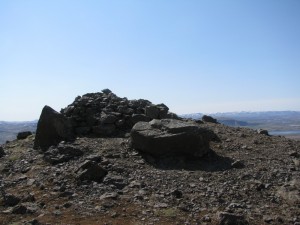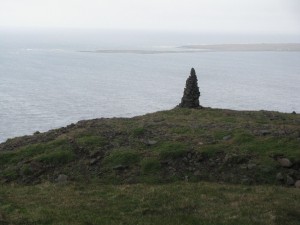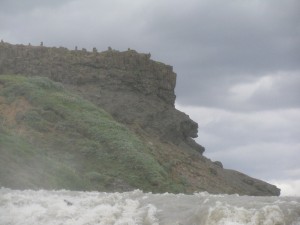Kilroy may have been here. Posted by hulda on May 20, 2012 in Icelandic culture, Icelandic customs, Icelandic history
 Once you travel outside of Reykjavík you will sooner or later come across certain stone-built landmarks, cairns, also known in Icelandic as varða/vörður. Their use is varied to say the least. Traditionally they marked borders, routes, shorelines, notable places and areas where an important travelling woman had died. Nowadays they also mark the presence of a passing traveler, an anonymous notification left by someone who once walked by.
Once you travel outside of Reykjavík you will sooner or later come across certain stone-built landmarks, cairns, also known in Icelandic as varða/vörður. Their use is varied to say the least. Traditionally they marked borders, routes, shorelines, notable places and areas where an important travelling woman had died. Nowadays they also mark the presence of a passing traveler, an anonymous notification left by someone who once walked by.
Varða are usually only made of a pile of stones but once upon a time they could also be made out of soil. However, there was a certain type of varða that was only made of stone, beinakerling, the “bone woman”. They were erected in memory of förukonur, traveling women who lived outside of society and brought news and gossip along whenever they came to a village. They often traveled in groups although solitary förukonur are also known. Beinakerlingar were different from vörður in that instead of rocks people used to leave them poems, beinakerlingavísur, wrapped up inside a hollow bone that was then stuck between the rocks. These poems were often very risky or even downright pornographic, and the oldest known such beinakerlingavísa dates from the 17th century. Some well-known beinakerlingar are in Kaldadalur, Stórasandur and Sprengisandur to this day.
 The way these varða usually get built is that someone begins one by placing a couple of rocks together. People passing by later on will then each add more stones, rocks or even pebbles on the pile and the most visited sights tend to have huge varða or several, which just keep on growing. It’s been said that you can tell a lot about a person by the way they add to a varða and by the place they choose for their stone. I prefer to put mine somewhere near the bottom of the pile and wedge it well in its place. Someone might just throw a rock at them and another might balance theirs on top in an artful manner. The evidence is all around and on top of the varða for anyone to read.
The way these varða usually get built is that someone begins one by placing a couple of rocks together. People passing by later on will then each add more stones, rocks or even pebbles on the pile and the most visited sights tend to have huge varða or several, which just keep on growing. It’s been said that you can tell a lot about a person by the way they add to a varða and by the place they choose for their stone. I prefer to put mine somewhere near the bottom of the pile and wedge it well in its place. Someone might just throw a rock at them and another might balance theirs on top in an artful manner. The evidence is all around and on top of the varða for anyone to read.
Vörður are a very usual sight to people who like to go hiking. They often mark the most walked paths, best walkways and crossings at rivers. Following them one can often see a line of vörður climb down a side of a mountain, stretch across a whole valley and then go up another mountain’s side. They can be seen even at places where one wouldn’t think anyone would like to travel but as I once witnessed in Hólssandur, a barren wasteland near Mývatn in the north, hikers in Iceland will sometimes find no challenge too big. If there’s a marked route someone will walk it and if there isn’t one, a path may always be made. Eventually this path, too, will be marked with vörður built by unknown people on their way from one place to another.
 The varða has evolved, much due to the way people like to find new paths and mark them. Nowadays their most important meaning is to mark that you have been to the place where it’s situated, or in case of the most famous ones, that you’ve been to the varða itself. Therefore even previously marked paths can have these stone piles if they f.ex. lead to a difficult route or a notable destination, for example the top of a mountain or an unusually beautiful waterfall. They are also in places where no sane person would ever venture to go to, in which case their meaning as a road sign is quite useless. This type of a varða is built for the sole reason of showing off to the world that a place that may once have been impossible to reach has been reached. By someone. It means very little who it actually was but what is very, extremely important is that they left a mark when they got there. Indeed, a varða can tell you a great deal about the people who built it.
The varða has evolved, much due to the way people like to find new paths and mark them. Nowadays their most important meaning is to mark that you have been to the place where it’s situated, or in case of the most famous ones, that you’ve been to the varða itself. Therefore even previously marked paths can have these stone piles if they f.ex. lead to a difficult route or a notable destination, for example the top of a mountain or an unusually beautiful waterfall. They are also in places where no sane person would ever venture to go to, in which case their meaning as a road sign is quite useless. This type of a varða is built for the sole reason of showing off to the world that a place that may once have been impossible to reach has been reached. By someone. It means very little who it actually was but what is very, extremely important is that they left a mark when they got there. Indeed, a varða can tell you a great deal about the people who built it.

Build vocabulary, practice pronunciation, and more with Transparent Language Online. Available anytime, anywhere, on any device.
About the Author: hulda
Hi, I'm Hulda, originally Finnish but now living in the suburbs of Reykjavík. I'm here to help you in any way I can if you're considering learning Icelandic. Nice to meet you!



